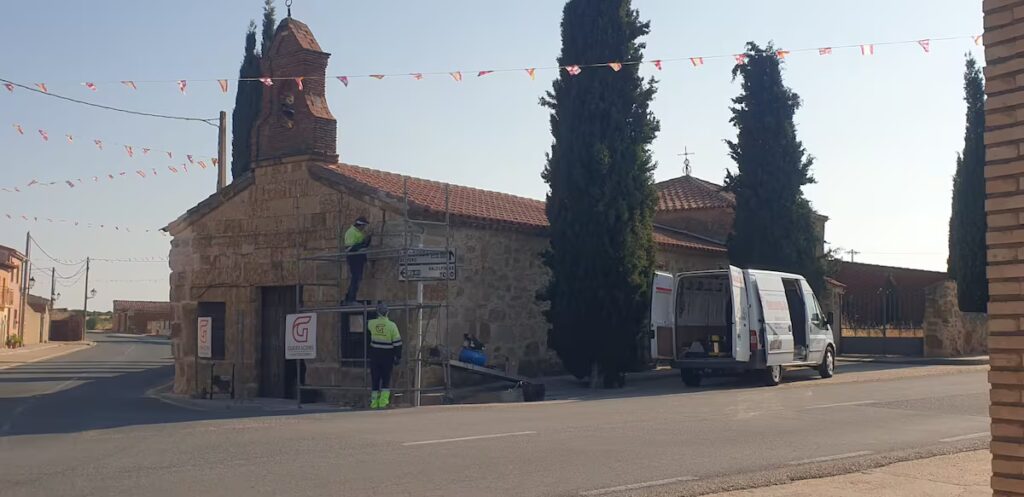
The Hermitage of Veracruz in Venialbo (Zamora), as well as the church and the parish house, were three of the 10,243 assets (1,613 in Zamora alone) that the Catholic Church registered (registered in its name in the real estate register) between 1998 and 2015. Specifically, the ecclesiastical institution became the owner of these assets in 2015 and, since then, the mayor of this municipality of Zamorano, Jesús Vara, assures in conversation with EL PAÍS, both the hermitage and the parish house are in the process of abandonment: “No one takes care of cleaning anymore, nor are events held.”
In June, the councilor met with the diocese of Zamora – on which the parish of Asunción de Venialbo, the current owner of the assets, depends – and reached an agreement for the free transfer of ownership of the hermitage to the municipality (provided that Catholic morals and customs are respected), and the purchase (for its cadastral value: 11,000 euros) of the parish house. Pact which was then signed by the entire City Council.
It seemed that the hermitage was about to return to the town, which for the neighbors is its legitimate owner. “We are all parishes” says the mayor. But between June and September, when the Bishopric of Zamora was about to officially authorize the operation, the parish priest disagreed with the agreement and it was broken.
From the diocese of Zamora, in statements to this newspaper, they assure that what they can do in this case is to put the parish system in the area in contact with the City Council and that there must be an agreement between them. They recognize that what interests them “is that the property has a use and that the Church reserves the right to use it for ecclesiastical activities”.
Popular consultation
Jesús Vara underlines that Venialbo is a town with a lot of devotion. Once upon a time there were three hermitages, remember, but now only the one in Veracruz remains. Until 2015, the year of registration, the Brotherhood of the Christ of Veracruz took care of its maintenance and cleaning, as well as organizing various events, such as the veneration of May 3, the processions during Holy Week or the auction (which granted the highest bidders the “privilege” of taking the Christ out to walk about 15 or 20 steps). Proceeds from the auction were used to pay for electricity and general maintenance costs. None of this is done anymore. And the degradation of the hermitage is progressive, and aggravated because recently a truck took away “half a corner”, even if it is now repaired.
They want to ennoble and revitalize the hermitage. With the road to an agreement dead, the mayor has decided to hold a popular consultation and, if the majority of the inhabitants of Venialbo support that the temple once again belongs to everyone, he will tell the Bishopric “that this is the will of the people”.
The councilor clarifies that he has nothing against the parish priestI feel like he understands that since he has eight cities, he can’t do deeds in all of them. It is also understood that he does not live in the parish house of Venialbo but, in this case, in that of El Piñero. And he praises the role of the Bishopric, “which was in favor of the people, and is willing to give up the hermitage for free and sell the parish house at a very low price”, he underlines. Therefore, if his neighbors want it, he thinks it is better for the brotherhood to take care of it again.
He assures us that we want it to continue to be a place of worship, “so that it fulfills its function as a hermitage”. With the parish house, uninhabited for 10 years and in need of restoration, there are plans to fix it up and use it as a cultural center or even for social rent. It is preferable, he explains, “than leaving everything like that and, in three or four years, an investor comes along and does a private deal.” “I want it to be for everyone, for the people,” he adds.
Inscriptions of the Catholic Church
According to the Royal Spanish Academy, registration consists of “registering a property for the first time in the property register”. The Church took advantage of this system using, first, the Mortgage Law of the Franco regime of 1946 and, then, José María Aznar’s reform of the Mortgage Regulations of 1998. Until, as Secular Europe points out, “Rajoy, alerted by the judicial sentences caused by this plunder, reformed the Mortgage Law (LH) on 25 June 2015, canceling the Church’s privilege, but without by reversing the recordings.”
The Catholic institution has profited very well from these 17 years (between 1998 and 2015) since, according to a study presented by the Ministry of the Presidency in 2021, it has appropriated more than 35,000 real estate properties throughout Spain.





